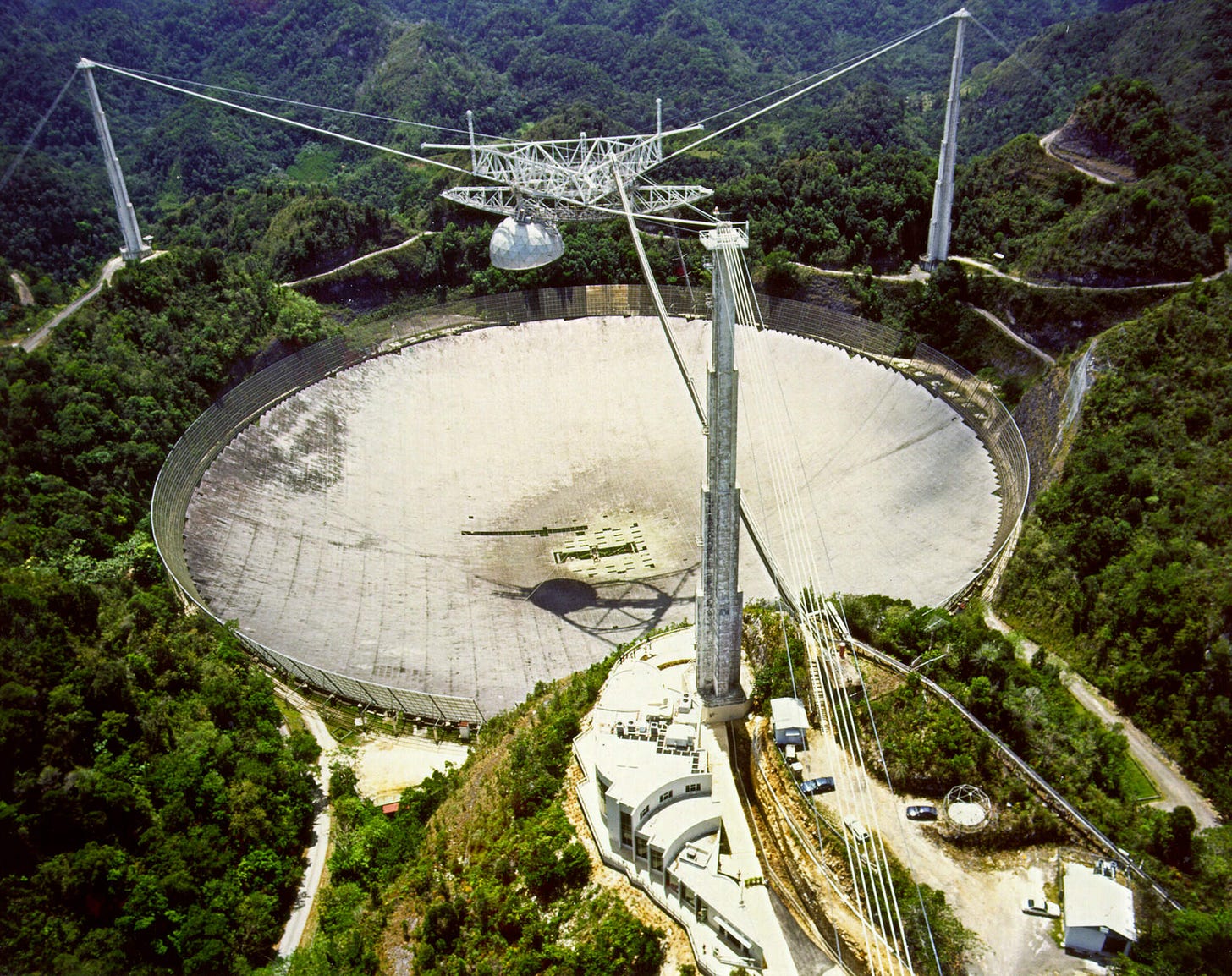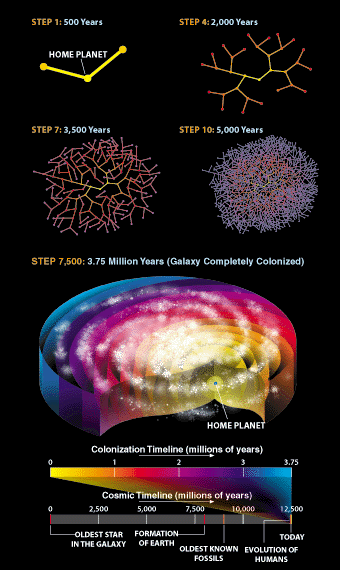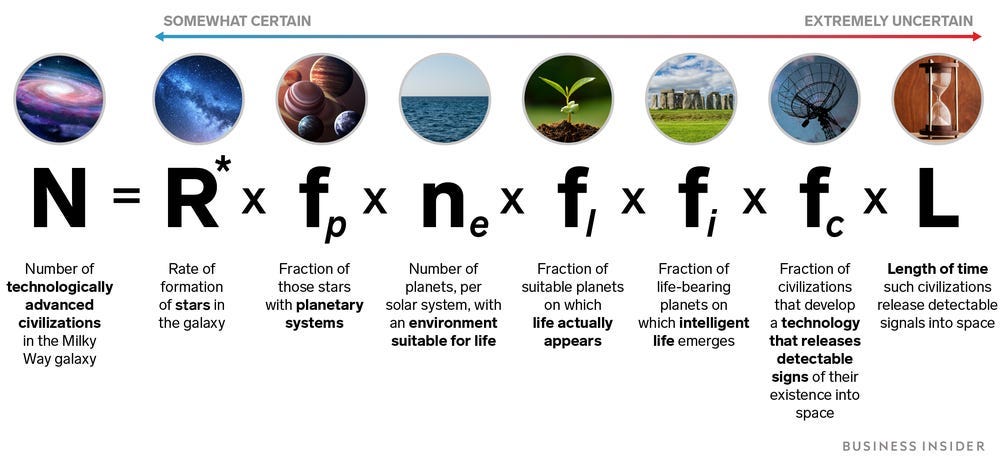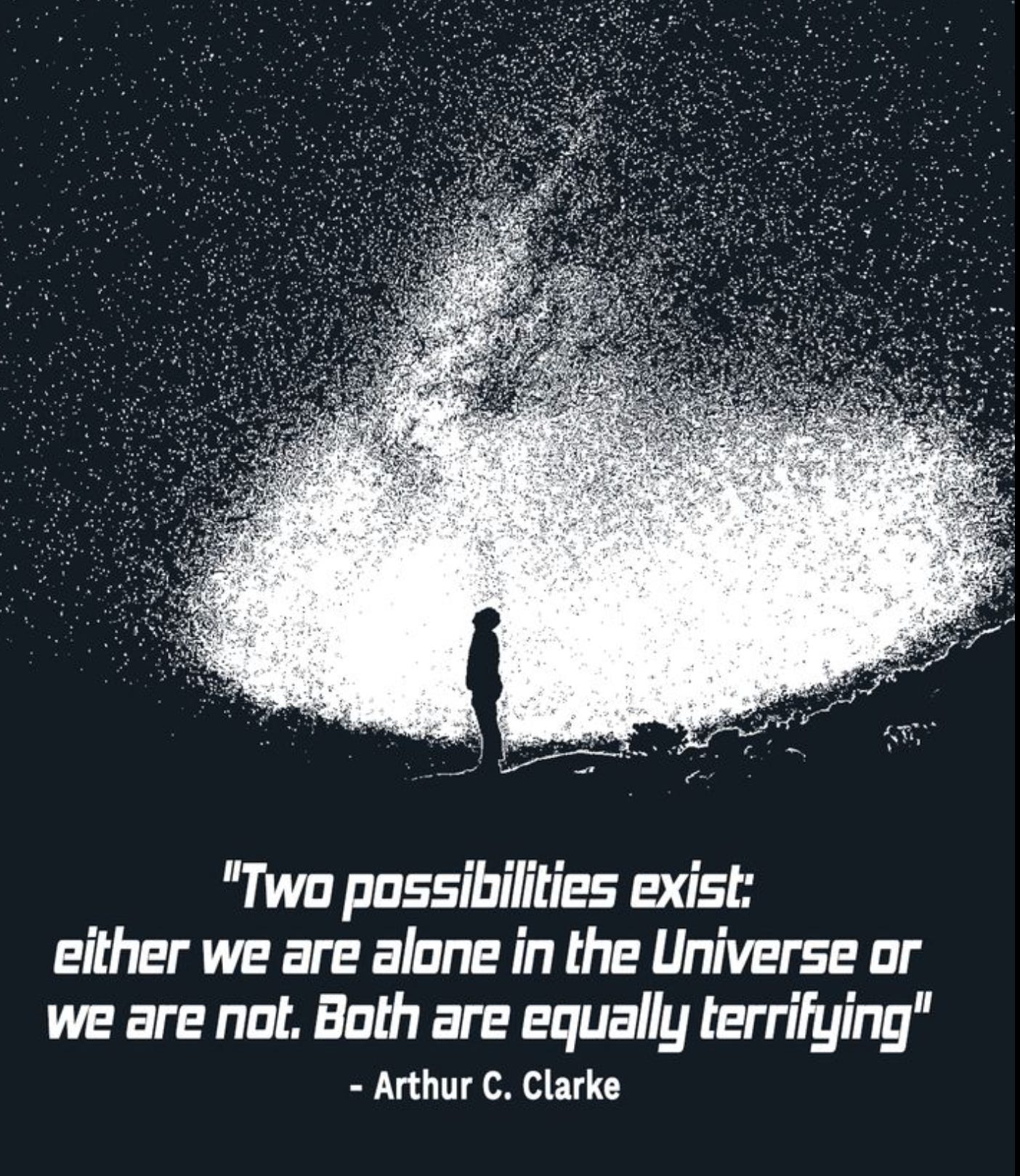Is There Anybody Out There?
A rumination on the Fermi Paradox and where its pursuit could lead us.
In vastness deep, where stars ignite,
Fermi asked, "Where is alien life?"
Our math suggests they should be rife,
Yet silence reigns in day and night.
Perhaps we're rare, a cosmic gift,
Or maybe our search needs a shift.Are they hidden, or long extinct?
Or trapped like us on worlds apart?
Our knowledge lacks, our views distinct,
On life's great chain, where does it start?
From RNA to cosmic mind,
What filters leave us here behind?
I have been utterly fascinated with the Fermi Paradox for quite some time now. Apart from the question of whether there is intelligent life1 elsewhere in the universe and the fanciful solutions one can conjure up in answer to that question, it also inevitably leads me to pondering over the importance of life itself (biological or otherwise), it’s purpose in the grand scheme of things and what the future of our universe itself will look like.
What is the Fermi Paradox?
The universe is a very very large place. As Douglas Adams states in The Hitchhiker’s Guide to the Galaxy,
“Space is big. Really big. You just won't believe how vastly hugely mind-bogglingly big it is. I mean, you may think it's a long way down the road to the chemist, but that's just peanuts to space.”
The universe is also incredibly old. Given the immense scales of time and space we are dealing with, the probability and likelihood should be that there exists other intelligent life in the universe. That notwithstanding, we haven’t seen any evidence of other extraterrestrial intelligence at all (to date). This contradiction of how likely life should be, but how we cannot see any evidence of other life at all is Fermi’s paradox.
It's like hosting a massive party and wondering why no one has shown up yet - did we get the date wrong, or are we just not cool enough to hang with the extraterrestrial crowd?
Some scientists speculate that the reason we haven't made contact with aliens is because they simply don't exist, which is a bummer for those of us hoping to have a close encounter of the third kind. Others propose that advanced extraterrestrial civilizations (ETCs) may have already come and gone, leaving behind only their space debris and their eerie silence. Perhaps they all decided to hop on a cosmic cruise ship to another galaxy, or maybe they just realized that building a Dyson Sphere was too much of a hassle.
Of course, there are also those who believe that we simply haven't searched hard enough, or that we're not looking in the right places. It's like losing your keys and only checking the same spot over and over again - sometimes you just have to think outside the box. Who knows, maybe aliens are just really good at hide and seek, or they're waiting for us to upgrade our technology before revealing themselves.
But why is it called Fermi Paradox? During a lunch discussion on UFO sightings with his Manhattan Project colleagues, the famed physicist Enrico Fermi allegedly blurted out,
“But where is everybody?”
With billions of galaxies in the universe and trillions of stars with planets, it would seem intuitive that life might have generated elsewhere as well in a teeny tiny percentage of those planets. And that a fraction of a percentage of those would have likely spread across their galaxies and hence we should be seeing some evidence of intelligent life in the universe. Instead, we see absolutely none. As of today, there’s ZERO evidence that we can point to and say, yes there’s possibly intelligent life elsewhere.
The Fermi Paradox explainer by SETI states - "Fermi grasped that any civilization with a modest amount of rocket technology and an immodest amount of imperial incentive could rapidly colonize the entire galaxy. Within a few tens of millions of years, every star system could be brought under the wing of empire. Tens of millions of years may sound like a long project, but in fact it’s quite short compared to the age of the galaxy, which is roughly a thousand times more."
Sir Francis Drake later came up with an equation to estimate the likelihood of another technologically advanced civilizations in the universe. I won’t go into too much detail on the formula itself but the picture below should be self explanatory.
R and fp are fairly well established today but fi, fc and L are as good as anyone’s guesses. Depending on what your assumptions are of any of these fractions, N could turn out to be as large as a few billions or as small as 0. It's therefore important to remember that the Drake Equation is not a precise calculation, but rather a framework for thinking about the factors that could influence the existence and detectability of extraterrestrial civilizations.
As our understanding of these parameters gets better in the years to come, it might just be that the actual probability of detecting another civilisation turns out to be close to zero which is why we haven’t seen anyone else ‘out there’. That might solve the apparent paradox itself (that we should be seeing ETCs but aren’t), but doesn’t answer the underlying question lurking within Fermi’s paradox - is there anybody actually out there? How far do we have to go or how long do we have to wait until we can know?
Before we answer that…
My Favourite Potential Solutions to the Paradox
“Potential” being the key word and in no order of preference.
The Dark Forest Theory: I first came across this while reading the second book in the Three Body Problem Trilogy aptly named “The Dark Forest.”2 This theory suggests that advanced civilizations may be intentionally avoiding contact with other civilizations out of fear of competition or conflict. This would explain why we haven't detected any signals or signs of their existence.
The argument in the book is laid out like this:
All life desires to stay alive.
There is no way to know if other lifeforms/ETCs can or will destroy you if given a chance.
Lacking assurances, the safest option for any species is to annihilate other life forms before they have a chance to do the same.
The hypothesis stems from the idea that civilizations in the cosmos are cautious and secretive because any other intelligent life they encounter might be a potential threat. Since the resources in the universe are finite, civilizations face the risk that others may try to destroy them to protect themselves. As a result, the best strategy for survival is to remain undetected, viewing the universe as a dangerous place where revealing one's existence could invite annihilation. Therefore, civilizations are in a state of mutual distrust, leading to a "silent" universe where communication is rare or absent.3
"The universe is a dark forest. Every civilization is an armed hunter stalking through the trees like a ghost, gently pushing aside branches that block the path and trying to tread without sound. Even breathing is done with care. The hunter has to be careful, because everywhere in the forest are stealthy hunters like him. If he finds other life—another hunter, an angel or a demon, a delicate infant or a tottering old man, a fairy or a demigod—there's only one thing he can do: open fire and eliminate them."
While the Dark Forest Theory offers one intriguing explanation, there are many other fascinating possibilities to consider.
The Transcension Hypothesis, proposes that ETCs may have evolved beyond the need for physical exploration. Instead, they might have "transcended" into virtual realities or higher dimensions, leaving no detectable traces in our observable universe. Imagine a civilization so advanced that it can upload its consciousness into a digital realm, free from the constraints of physical space and time. It's a scenario straight out of science fiction, but one that could explain the cosmic silence.
Taking the simulation idea further, the Planetarium Hypothesis suggests that our entire reality could be a sophisticated simulation created by a higher intelligence. The absence of alien encounters may be a programmed feature designed to maintain the illusion of a lonely universe. It's a trippy concept that calls into question the nature of our existence and the limits of our perception.
On the other hand, the Gaian Bottleneck hypothesis brings us back down to Earth, proposing that the complex conditions necessary for life to evolve into a technologically advanced state are incredibly rare. Most life-bearing planets might face extinction events before reaching that stage, making intelligent life a scarce commodity in the cosmos. A sobering reminder of the fragility of life and the challenges it must overcome to thrive.
The Temporal Hypothesis takes a different approach, suggesting that ETCs might exist in different temporal dimensions, making simultaneous contact impossible. We could be like ships passing in the night, unaware of each other's presence due to the vagaries of cosmic time. It's a mind-bending concept that challenges our linear perception of time and raises questions about the nature of causality.
Blending the Temporal Hypothesis with the Many Worlds Interpretation of quantum physics leads us to the Interdimensional Hypothesis which suggests that extraterrestrial civilizations might exist not only in different temporal dimensions but also in parallel universes, making contact nearly impossible due to mismatched timelines and realities. Just as time may not flow uniformly across the cosmos, civilizations could evolve in different temporal layers or parallel worlds where quantum events cause reality to diverge. Brief windows of interaction might be possible through fleeting quantum bridges, but direct communication would be rare and unpredictable—like ships passing in the night across both time and dimensions—challenging our linear perception of time and causality. It's a concept that stretches the limits of our imagination and invites us to consider the possibilities of a reality beyond our own.
The Isolationist Hypothesis, on the other hand, suggests that advanced civilizations might choose to limit their expansion and remain within their own star systems. The risks and challenges of interstellar travel and potential conflicts with other lifeforms may outweigh the benefits of cosmic exploration. It's a pragmatic approach that emphasizes the importance of self-preservation and the dangers of venturing into the unknown.
To read about more such solutions, please go pick up Stephen Webb's book "If the Universe Is Teeming with Aliens ... WHERE IS EVERYBODY?" which offers a comprehensive exploration of the Fermi Paradox. Webb presents 75 possible explanations, ranging from the mundane to the exotic. These solutions fall into three broad categories: 1) They are here, but we haven't noticed, 2) They exist, but we haven't detected them yet, and 3) They don't exist.
While no single solution definitively resolves the paradox, the book underscores the complexity of the question and the wide range of factors we must consider in our search for extraterrestrial life.
Claims of Solutions to the Paradox
I am generally very wary of anyone claiming that they have comprehensively solved the Fermi Paradox already. Such claims often rely on a set of assumptions that, while seemingly reasonable, may not fully capture the complexity and uncertainty inherent in the question of extraterrestrial life.
Take, for example, the paper "Dissolving the Fermi Paradox" by Sandberg, Drexler, and Ord. While their approach is more nuanced than many other attempts to resolve the paradox, it still relies on certain assumptions that can be questioned:
Uncertainty Modeling: The paper's main argument revolves around incorporating uncertainty into the Drake Equation parameters. While this is a step in the right direction, the way they model this uncertainty (using log-normal distributions for some parameters) is still an assumption. The true nature of our uncertainty might not be accurately captured by these probability distributions.
Independence of Variables: The analysis assumes that the various factors in the Drake Equation are independent. However, there could be complex interrelationships between these factors that are not accounted for in this model.
Anthropic Bias: The paper doesn't fully address the potential for anthropic bias in our observations. The fact that we exist to observe the universe already conditions our expectations in ways that are difficult to quantify.
Limited Observational Data: The paper uses the lack of observed civilizations as evidence, but our search for extraterrestrial intelligence has been limited in scope and duration. We've only been looking for a few decades, which is a blink of an eye in cosmic timescales.
Technological Assumptions: The analysis makes implicit assumptions about the nature of detectable civilizations, which may not encompass the full range of possible technological development paths.
Time-Independence: The Drake Equation, and by extension this analysis, assumes a steady-state universe. However, the conditions for life and intelligence may vary significantly over cosmic time.
Definition of Life and Intelligence: The paper, like many discussions of the Fermi Paradox, assumes definitions of life and intelligence that may be too narrow or Earth-centric.
While the paper provides an interesting perspective on the Fermi Paradox, it's important to remember that it's not a definitive solution, but rather another way of framing our uncertainty. The authors themselves acknowledge this, stating that their conclusion is "a statement about our state of knowledge, rather than a new measurement."
Another example is the paper "Solving the Fermi paradox without assumptions" by Berezin Alexander. This paper claims to provide a universal solution to the Fermi paradox based on the definition of life and intelligence. While this paper presents an interesting thought experiment, it falls into the same trap as many other proposed solutions to the Fermi Paradox: it makes sweeping generalizations about the nature of life, intelligence, and civilizational development based on limited Earth-centric understanding and simplified models.
The Fermi Paradox remains a complex and multifaceted problem. Any claimed solution should be approached with healthy skepticism, as it's likely that there are factors and complexities we haven't yet considered. The paradox serves as a reminder of how much we still have to learn about the universe and our place in it.
As Carl Sagan once said, "Extraordinary claims require extraordinary evidence." While it's tempting to latch onto solutions that seem to resolve the paradox neatly, we must remember that the question of extraterrestrial life is one of the most profound and complex that humanity has ever grappled with. It's unlikely to be resolved by any single study or theory.
Instead of claiming to have solved the paradox, perhaps a more productive approach is to use it as a framework for exploring our assumptions, refining our search methods, and deepening our understanding of the conditions that give rise to life and intelligence in the universe.
What Next?
As we grapple with the profound implications of the Fermi Paradox, humanity stands at the threshold of a new era of cosmic exploration. In the coming years, decades, and centuries, we have the opportunity to take bold steps towards unraveling the mystery of our apparent cosmic solitude. By actively seeking out signs of extraterrestrial life and intelligence, we may finally find the answers we have long sought. There aren’t many more such audacious yet noble callings.
In the near future, we can intensify our efforts to detect techno-signatures, the telltale signs of advanced civilizations, by conducting extensive searches using our most powerful telescopes and listening devices. Projects like the Square Kilometre Array (SKA) and the Next Generation Very Large Array (ngVLA) will vastly expand our ability to detect faint radio signals from distant stars, potentially uncovering the first evidence of extraterrestrial intelligence. Additionally, we can send targeted radio messages to promising star systems, announcing our presence and inviting a response from any civilizations that may be listening.

As we look further ahead, the next few decades could see the launch of ambitious interstellar missions designed to study potentially habitable worlds up close. By sending probes to nearby star systems, such as Alpha Centauri and TRAPPIST-1, we can gather invaluable data about the conditions on these alien worlds and search for signs of life. Advances in propulsion technology, such as laser-powered lightsails and nuclear-powered spacecraft, could enable us to send these probes at unprecedented speeds, reducing the travel time to a matter of decades rather than centuries.
von Neumann probes also offer an exciting way forward in our future exploration efforts. These self-replicating spacecraft, named after mathematician John von Neumann, could change how we search for alien life and explore the galaxy. The concept is straightforward: send out a probe that can reach a distant star system, use materials there to make copies of itself, and launch these copies to more distant stars.
From the Wikipedia article:
In theory, a self-replicating spacecraft could be sent to a neighbouring planetary system, where it would seek out raw materials (extracted from asteroids, moons, gas giants, etc.) to create replicas of itself. These replicas would then be sent out to other planetary systems.
…
It has been theorized that a self-replicating starship utilizing relatively conventional theoretical methods of interstellar travel (i.e., no exotic faster-than-light propulsion, and speeds limited to an "average cruising speed" of 0.1c.) could spread throughout a galaxy the size of the Milky Way in as little as half a million years.
This approach could allow us to explore the entire galaxy much faster than with traditional spacecraft. It's an exciting idea that could speed up our search for extraterrestrial life. But it also raises questions. Also given that this technology is possible for even us humans in the near future, why haven't we seen signs of it being used by other civilizations?

As our technology advances, we might be able to create these probes ourselves. This could open up new ways to explore space and search for alien life. For now, the idea of von Neumann probes reminds us that there's still a lot to learn about the universe and our place in it.
In the more distant future, humanity may embark on one of the most audacious endeavors ever conceived: the construction of generation ships. These self-sustaining, city-sized spacecraft would carry thousands of people on a one-way journey to the stars, spanning multiple generations. By establishing human colonies on distant worlds, we could ensure the long-term survival of our species and increase our chances of encountering extraterrestrial life. As these colonies take root and flourish, they may become beacons of humanity's presence in the galaxy, attracting the attention of any advanced civilizations that may be searching for signs of intelligent life.
![The Nauvoo - Generation Ship from The Expanse (TV Series) [OS] [1200×900] : r/StarshipPorn The Nauvoo - Generation Ship from The Expanse (TV Series) [OS] [1200×900] : r/StarshipPorn](https://substackcdn.com/image/fetch/$s_!R82i!,w_1456,c_limit,f_auto,q_auto:good,fl_progressive:steep/https%3A%2F%2Fsubstack-post-media.s3.amazonaws.com%2Fpublic%2Fimages%2F06a8993c-c3b6-4092-822e-969ef1e6c45e_1080x810.jpeg)
As we pursue these ambitious projects, we must also remain open to the possibility that the answer to the Fermi Paradox may be more complex than we currently imagine. It is possible that advanced civilizations have evolved beyond our understanding, adopting forms of communication and technology that we cannot yet comprehend. By remaining curious, adaptable, and persistent in our search, we may one day crack the cosmic code and establish contact with our galactic neighbors.
In the meantime, the Fermi Paradox serves as a powerful reminder of the importance of cherishing and protecting the life we have here on Earth. As we continue to search the stars for signs of intelligent life, we must also work to create a sustainable, peaceful, and thriving civilization here at home. By embracing our shared humanity and working together to overcome the challenges we face, we can lay the foundation for a future in which we are ready to take our place among the stars and solve the greatest mystery of our time.
Conclusion (to the article, not the paradox!)
In the vast expanse of the universe, we find ourselves alone, a solitary oasis of life amidst an endless desert of stars. The Fermi Paradox, a haunting question that echoes through the ages, asks: where is everyone? If the cosmos is so vast and ancient, surely we should have encountered other civilizations by now. Yet, the silence of the universe is deafening, a poignant reminder of our isolation in the face of infinity. The scale of the universe is staggering, with billions of galaxies stretching out across unfathomable distances, each potentially harboring countless worlds and civilizations. And yet, we remain the only known sentient beings, a flicker of consciousness in an otherwise indifferent cosmos.
Our existence, a mere blip on the cosmic timeline, is a fleeting moment in the grand scheme of things. The universe has been evolving for nearly 14 billion years, a testament to the immense age and scale of the cosmos. Our own story, the rise of humanity and our quest for understanding, has only just begun. In the face of such vastness and the apparent absence of other intelligent life, we are left to ponder our place in the universe and the meaning of our solitary existence. The Fermi Paradox serves as a sobering reminder of the challenges we face in our search for cosmic companionship and the potential rarity of life in the universe.
Yet, even in our isolation, we continue to dream, explore, and reach for the stars. The Fermi Paradox, rather than discouraging us, should serve as a catalyst for our curiosity and drive to unravel the mysteries of the cosmos. It needs to be one of the reasons why it is important to send our probes and telescopes and eventually our own selves into the void, seeking signs of life and the answers to our most profound questions. And though we may find ourselves alone, we can take solace in the knowledge that we are the universe's way of understanding itself, a cosmic miracle born of stardust and time. Our brief existence, though fleeting, is a testament to the resilience and wonder of the human spirit, forever seeking to illuminate the darkness and find our place among the stars.
Please note the use of “intelligent” life here. Life might still exist in the form of microscopic organisms etc. but then it would be even harder to detect such proof billions and trillions of miles away.
Some books apart from “The Dark Forest” I liked that talk about the Fermi Paradox - the Revelation Space series by Alaistar Reynolds, “Blindsight" by Peter Watts, "Existence" by David Brin, "The Forge of God"by Greg Bear, "Pushing Ice" by Alastair Reynolds.
Despite the cosmic silence we've encountered, humanity has made several deliberate attempts to announce our presence to the universe. These efforts range from radio broadcasts to physical artifacts sent into space. The Arecibo message, transmitted in 1974 from the Arecibo radio telescope in Puerto Rico, was a 1679 bit-long binary message aimed at the globular star cluster M13. It contained basic information about humanity, Earth, and our solar system. The Voyager Golden Records, launched in 1977 aboard the Voyager 1 and 2 spacecraft, contain sounds and images portraying the diversity of life and culture on Earth, including 115 analog-encoded photographs, greetings in 55 languages, a selection of music from various cultures, and audio of Earth sounds like wind, rain, and animal noises. More recent efforts include the "Cosmic Call" messages sent in 1999 and 2003 from the Evpatoria Planetary Radar, and various crowd-sourced messages transmitted by the EISCAT facility in Norway. These broadcasts represent humanity's hope of making contact, but also spark debate about the wisdom of revealing our existence to unknown civilizations. Let’s just hope we don’t have a dimensional strike on its way to the earth right now.






This is so well written , I urge you to continue writing and please do give a reading recommendation . I am eagerly looking forward to your writing
Just amazingly written! Each and every article very well researched and meticulously articulated.